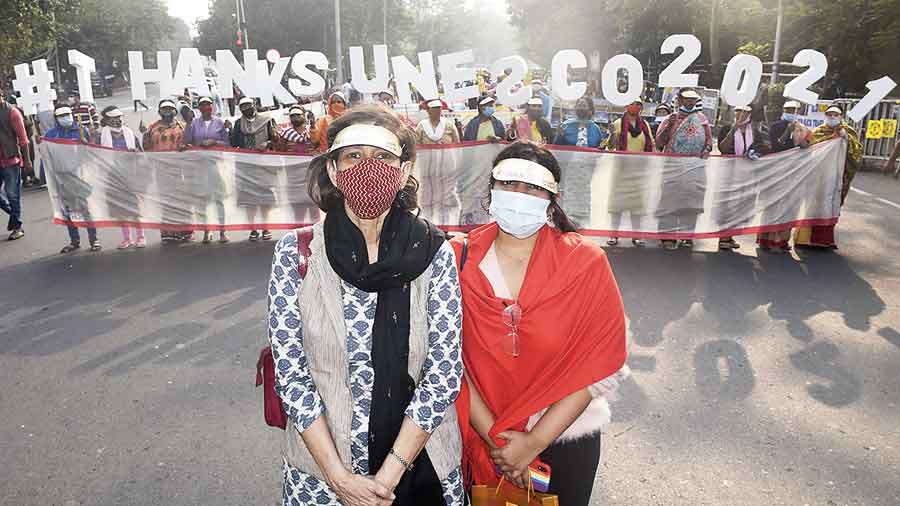Tapati Guha Thakurta Of: CD Block
Occupation: Art historian
Achievement: Compiled the dossier sent to Unesco seeking inscription of the city’s Durga puja on its Representative List of Intangible Cultural Heritage of Humanity
The Salt Lake resident was instrumental in achieving the inscription of the city’s Durga Puja on the Unesco’s Representative List of Intangible Cultural Heritage of Humanity. Tapati Guha Thakurta of CD Block led a team of researchers, including Devi Chakravarti of DB Block, to prepare the dossier that was sent to Unesco, at the behest of Sangeet Natak Akademi, under the Union ministry of culture. “The Unesco application is a very straitjacket one — a 25-page form, 10 photographs and a 10-minute film along with endorsement letters from the Puja stakeholders. You can write barely 150 to 300 words on each point. It is tough to describe something as vast as Durga Puja so briefly. I remember couriering it all on March 23, 2019, at the end of seven months of work," said the former director and honorary professor at the Centre for Studies in Social Sciences.
In July 2020, they had asked for subtitles to a Chandipaath clip used in the film but when there was no communication afterwards, she put it out of her mind.
This November, she started receiving queries from the ministry seeking clarifications. “It is then that I realised that the application was alive and was going through the final stages at the Unesco’s headquarters in Paris. And the officials were in so much haste that I’d get asked on a Sunday to respond before their meeting on Monday!”
The queries were on issues like sustainability, how feasible Durga puja was for international tourism and whether over-commercialisation would destroy the festival.
Her name does not appear anywhere in the dossier she sent as it went from the Sangeet Natak Akademi, which had sponsored the project, nor has she been thanked for her efforts after the inscription.
But Guha Thakurta is not complaining. She is rather looking forward to the city reaping the benefits of the festival reaching a global platform. “I have told puja organisers that their responsibility has increased manifold. With more tourists coming, there has to be an element of quality control and less commercial clutter.”
Sudeshna Banerjee

Vidushi Agarwal Of: Ultadanga
Achievement: Silver medallist in the 59th National Roller Skating Championship held in Delhi in December 11-13, 2021. Only medallist from Bengal this year.
The six-year-old skater, who trains under coach Victor Balmiki at Bidhan Sishu Udyan, had got two gold medals for the second consecutive year in the state championship in November to qualify for the finals. "There is no skating rink in the city. Even the state event is held on a 125m track around the basketball court at the Sports Authority of India (SAI) facility, while the nationals are held on 200m tracks. So we had to travel to Delhi weeks in advance so she could train there before her event," said her father Krishna Agarwal.
From a pleasant 23ºCelsius in Kolkata, the Bengal team had to perform in 4C in Delhi as the event is held outdoors. "For their age group of five to seven years, it takes place on a track rather than on the road," he added.
In the one lap inline (where the skate has three wheels in a single line) event, Vidushi finished just a second behind a Karnataka girl, clocking 28 seconds for a silver medal. In her other event, three-lap inline, she came sixth.
Vidushi has been skating since the age of four, following in the steps of her sister Kashish. "Their coach used to train them under the Clock Tower, at Owl Road or near Visarjan Ghat in New Town at dawn. During the second wave, classes went online, where technique and physical exercises were taught. It was difficult for such a small child. They resumed in-person classes in August," he added.
The cadet groups in three age categories were introduced at the national level in 2019 for quad (where the skates have two wheels each on both sides) and in 2020 for inline. "Last year, too, we had gone to Mohali where the nationals were held and all of us came back with Covid," Agarwal recalled. So this time, the return with a medal was double reason for celebration.
Akash Chakraborty
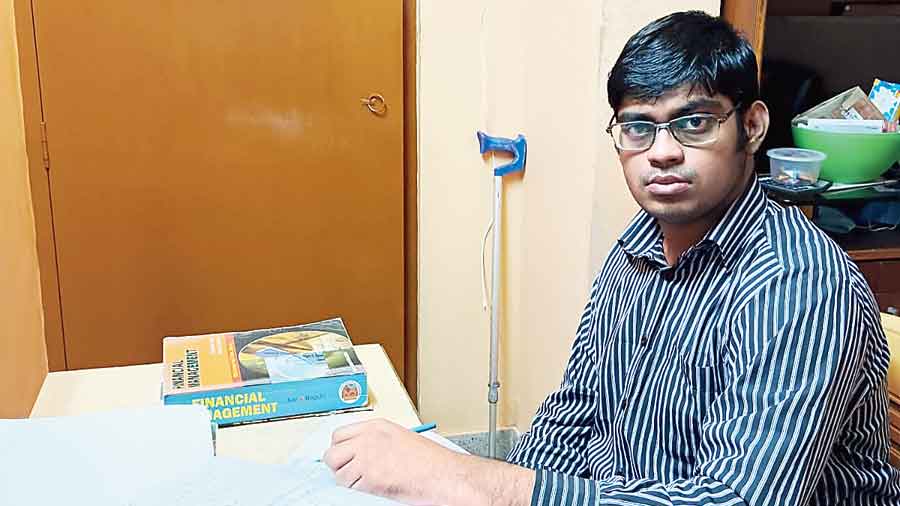
Of: Baguiati
Occupation: Student
Achievement: Akash Chakraborty completed MBA in finance from IISWBM Calcutta, securing 73.31 per cent marks this year.
This is yet another triumph in the face of adversity for the 23 year-old suffering from cerebral palsy since the age of six months.
In 2019, Akash completed B.Com (Hons.) from Goenka College of Commerce and Business Administration with 76.67 per cent marks. In the meantime, his CAT preparation was going on. He was selected for final admission at IIM Kozikode and IIM Raipur. But his physical disability deterred him from taking admission at the IIMs.
Earlier, the boy who needs crutches as well as help from his parents to put on his ankle foot orthosis braces, had secured 91.6 per cent in Class XII and CGPA 10.0 in Class X.
The journey has been uphill for the boy with 70 per cent disability, who has often battled discrimination and whose academic career would have got scuttled long back but for the never-say-die attitude of both him and his parents.
Now, the boy, who idolises 12-time World Wrestling Entertainment champion John Cena, is preparing for National Eligibility Test (NET) to become a college teacher.
Rabin Chakraborty
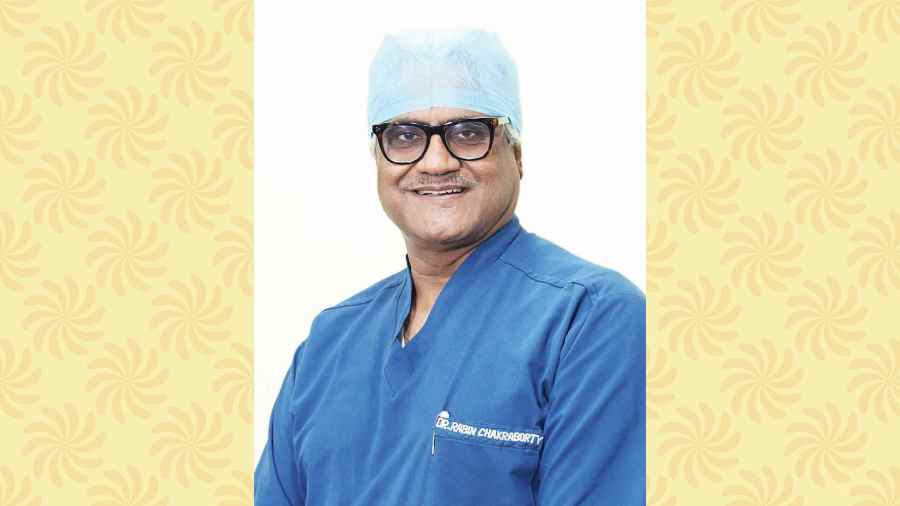
Of: BE Block
Senior interventional cardiologist Rabin Chakraborty, currently the senior vice-chairman and head of cardiology services at the Medica Group of hospitals, has been elected president, Indian College of Cardiology, for 2021. On Monday, he was also conferred the Dr K Sharan Cardiology Excellence Award by the Indian Medical Association in Patna.
“I was elected unanimously,” smiled the BE Block resident who settled in Salt Lake 14 years ago, when he was sent from Apollo Hospitals, Hyderabad to start the cardiology department of the hospital’s Calcutta branch on the Bypass which he would head till 2017. “This post and my unanimous election are a recognition of my credentials after 34 years of service as a cardiologist across the country and the world,” he said.
Chakraborty, 65, has been exposed to the cardiological set-ups of countries like the US and the UK where he worked in hospitals and has also performed surgeries in Vietnam, Muscat, Dubai, Belgrade, Malayasia and Bangladesh.
Sohini Das Hartmann
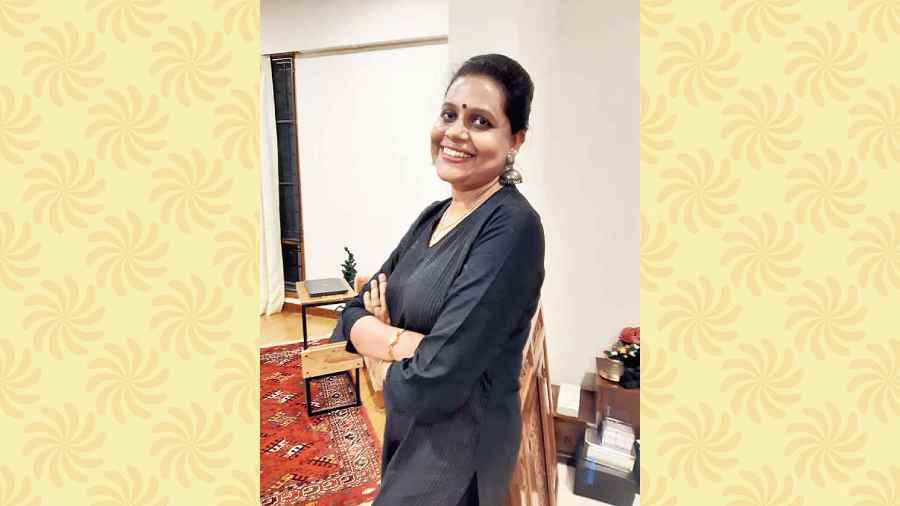
Of: FD Block
Occupation: Public engagement advisor for US Consulate, Calcutta
Achievement: Received the Public Diplomacy Achievement Award from the American Public Diplomacy Association for her work against trafficking.
“Bengal is both a transit and destination point for trafficking and has been an epicentre during the pandemic,” says Das Hartmann. “Many of the partners we work with say the pandemic has pushed efforts back by 20 or 30 years since migrant labourers have been going out of work and the school system has gone online which made it beyond access for much of rural India. Plus there was Cyclone Amphan.”
However, her team has been using sports and education to create awareness. “Our women’s leadership and hockey camp picked girls from the most heavily trafficked districts of Jharkhand.”
Their projects have received support from multiple stakeholders, including government, judiciary, law enforcement and civil society, and many have been adopted by local governments thereafter.
She also cites cases of trafficking survivors who have gone on to work with NGOs, trying to rehabilitate other rescued women.
Arpita Saha

Of: Labony Estate, now living in Georgia, US
Occupation: Associate professor, department of chemistry and biochemistry, at Georgia Southern University
Achievement: Governor Brian Kemp handed her the 2021 Felton Jenkins, Jr. Hall of Fame Faculty Award on behalf of the University System of Georgia. This is the governing body of all universities in the state. Saha was awarded especially for her innovative teaching strategies when the pandemic brought much to a standstill. Her research area is nanomaterials and environmental chemistry.
Saha was a student of Laban Hrad Vidyapith For Girls in EC Block, after which she went to Presidency College, IIT Kanpur and finally the US for her PhD. “While every institute has contributed to my success, I remember the teaching in India to be a monologue rather than project-based. I mentor my students now and allow them to research from Day I, not at the fag end of their education. To create the next generation of scientists, we have to give them tools and train them to question,” she says.
Saha is also working to create opportunities so students, especially women, acquire their degrees and continue to work in STEM (science, technology, engineering, mathematics) instead of shifting to other fields.
Soumen Pramanick
Rider of the year: 5,890 km over 11 days on a Harley

Five bikers recently rode from the Bangladesh border to the Pakistan border in a bid to promote unity among Indians. And this they did on their swanky Harley Davidsons.
“The Harleys made it much easier for us actually,” said Soumen Pramanick, one of the riders who lives in New Town’s CE Block. “The bikes drew constant attention and turned those of us riding them into celebrities. So many came for pictures that it became easier for us talk to people about communal harmony. It also helped that we had Hindus, a Muslim and a Sikh riding with us.”
The other riders were Pratip Chatterji and Surajit Paul of Dum Dum, Gurjit Singh Chawla of Hooghly and Saiful Islam Sekh of Sankalpa 3, New Town. “Another friend, Shyamadas De of HA Block, was to join us too. In fact, our planning was all done in his house. But he had to bail out in the last minute,” says Soumen.
The 5,890km journey began on November 15 from Benapole at the Bangladesh border and lasted 11 days. On Day 1, they halted at Benaras, then Agra, Ranthambore, Jodhpur and lastly at the Pakistan border in Jaisalmer, before heading back. The roads were good and they cruised at an average 100-110kph for eight to 10 hours a day. Their luggage would be saddled on the bike’s sides.
“Riding this way, we got to see how unique the culture of different states is. From Benaras, we bought saris for home and sent them by parcel, in Ranthambore we went for a jungle safari and saw a tiger, in Agra we had petha, in Rajasthan we had Dal Bati Churma...” smiles Soumen.
And the people they met were all welcoming. “They were excited to hear about our noble cause and wished us a safe ride. In Jaisalmer, Pratip's 380kg Fat Boy had a flat tyre. We were touched when some offered to take it to the garage on their jeep,” says Soumen, whose own phone mouthpiece (that is connected to his helmet) got spoilt and someone went out of the way to get him a replacement.
The men also found a man and two kids stuck in their car in the sand dunes of Jaisalmer and helped them out. “These helping hands here and there are what keep us bonded as Indians,” he summed up.
On stage at COP26
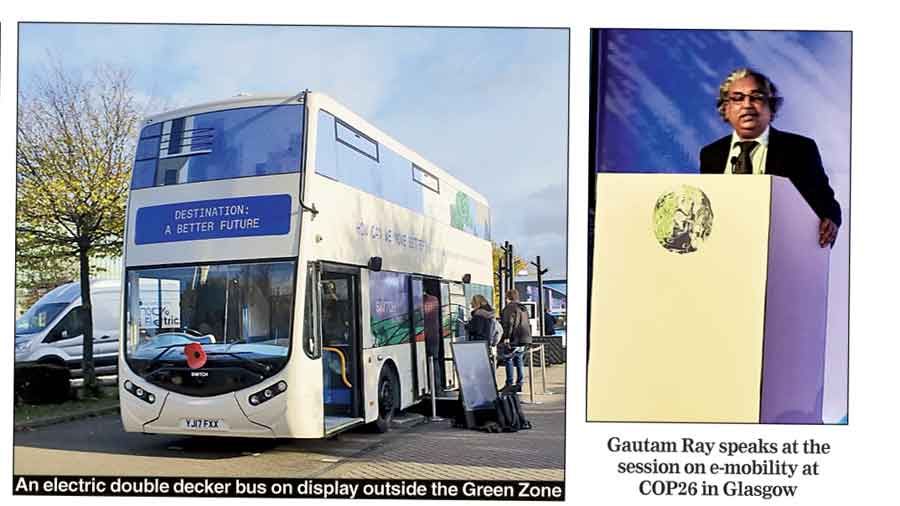
A Salt Lake resident moderated a session at the 26th United Nations Climate Change Conference, popularly known as COP26, which took place from October 31 to November 12 in Glasgow.
FE Block resident Gautam Ray is the senior vice-president of the Bengal National Chamber of Commerce and Industry (BNCCI) and chairman of BNCCI's energy and environment committee. "Sustainability is a focus area of our activities and we have been working on e-mobility. So we applied for a slot at COP 26 to showcase e-mobility in Calcutta. They gave us an hour and half.” The city, Ray points out, is one of the first in the world to be electrified and was also a forerunner in e-mobility through its electric-run tramcars.
On April 17, 1899, the first thermal power plant of The Calcutta Electric Supply Corporation Limited was commissioned at Emambagh Lane near Prinsep Ghat, heralding the beginning of thermal power generation in India. Soon after, in 1902, the Calcutta Tramways Company switched to electricity from horse-drawn carriages.
Three members, including Ray, traveled to Glasgow from Kolkata. “My wife Aditi and I spent a few days at a relative's place in a village near Manchester from where we took a train to the Scotland. In three hours, we reached Motherwell, a small town near Glasgow, where we spent a night before taking a taxi the next morning to the city where we stayed in a hotel right next to Glasgow Central, their rail station,” says Ray.
The panel discussion, curated by BNCCI on “Accelerating electric mobility with green jobs and gender parity”, took place on November 10, about a week after the World Leaders Summit ended.
“E-mobility is a big step in achieving the targets of emission reduction. Several automobile giants have pledged not to make diesel-run cars after 2030. Many countries have planned phasing out of fossil fuel-dependent cars,” says Ray.
Three things, he pointed out, are needed to achieve e-mobility - supply of electric cars at affordable cost, charging stations and manufacture of batteries and the participants, including the then Calcutta Municipal Corporation board of administrators head Firhad Hakim, addressed the session live on these points in person or virtually.
“Attendance in every session of COP26 was ticketed. So I was worried about audience size. Yet, the auditorium, seating 120-150, was full.”
The session took place in the Green Zone, hosted by the Glasgow Science Centre, which was open to the general public.
“The Green Zone was a melting pot of public sector and corporate sector entities, pressure groups, non-profits… It saw a convergence of multiple interests and focus groups,” Ray says.
The event included a display of zero-emission vehicles. “There was a double decker electric bus.”
Ray was at the summit for two days. “The event is a directional milestone in modern human history. It feels good to think my footsteps fell there,” he smiles.
Sanchari Sarkar
1,000 days through pregnancy and Covid

This 40-year-old from Uniworld City has weighed an extreme of 85kg at one point as well as an extreme of 39. And she then discovered a sport that not only made her fit but also gave her the zest to her return to it unflinchingly day after. Literally.
Sanchari Sarkar ran all through her pregnancy, through a bout of Covid and a few weeks ago completed an uninterrupted streak of 1,000 days of running. That’s nearly three years without a single day’s gap.
“I was an obese child and over the years had tried everything from living on cucumbers to skipping 10,000 times a day. Then I was introduced to running 10 years ago,” says Sanchari, who lived in Gurgaon then. It clicked for her and she started running races, marathons and finally streaks. “Streaking is when you running for a set number of days without a gap. If there’s a gap, you start all over again.”
She completed her first streak, of 100 days, in 2015. She followed it up with streaks of durations like 200 days, 365 days, two years and then 1,000 days looked achievable.
“But around the time I remember returning from a race and feeling strange. I did a home pregnancy test and it was positive,” says Sanchari, whose first reaction was to ring a fellow runner who is also a gynaecologist and say she wanted to continue running. And luckily for her, she was allowed to run throughout. “In fact, I finished a 200-day streak and was on a one or two-day break when my daughter was born.”
But while people are amazed that she ran through her pregnancy, Sanchari says it’s way tougher to get back at it after delivery. “By then, your body and centre of gravity have changed and everything is just tougher. I’d cry doing crunches and squats as I wasn’t able to do such simple exercises anymore,” says the lady who then turned to Ian Dexter, a British trainer, for help.
It took her months but she found her form. Her husband Neil Bhaumik, who plays tennis, would look after the baby while Sanchari headed out. In fact she began her 1,000-day streak when her daughter Zaara was six months.
Come rain, come shine the lady ran a minimum of two miles daily, with the data getting get clocked on her running smart watches TomTom and Amazefit.
They shifted from Gurgaon to New Town in 2020 and in June this year she got Covid. “Luckily I was asymptomatic and kept running on my treadmill without leaving home. If I was weak in the morning I ran at night. But having come so far I just couldn’t give it up,” she smiles.
Brinda Sarkar
Want to add to the list? Write in to saltlake@abp.in
